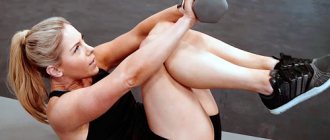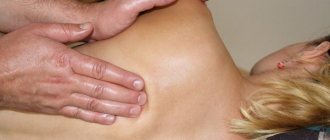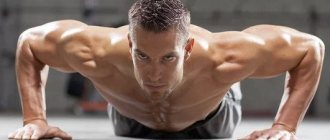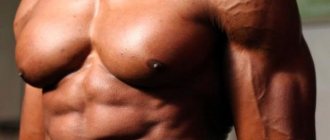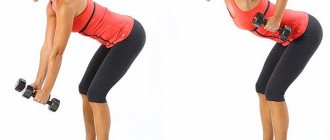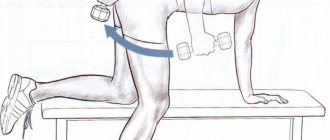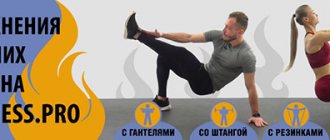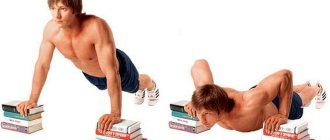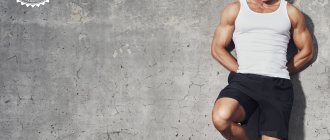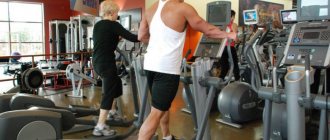Upper workout: back, shoulders and traps
Main goal:
gaining muscle mass
Type:
training a specific part of the body
Level of training:
beginner, intermediate
Number of workouts per week:
1
Necessary equipment:
barbell, dumbbells, exercise machines
Audience:
men
Put aside the light dumbbells, it's time to really load your torso and make it wider, thicker and more massive!
How much attention do we pay to our upper body? And now the conversation is not about chest or abs, but about those parts of the body, looking at which anyone will say: “Yes, this guy is seriously pumping!” We are talking about the back, shoulders and trapezius, because these are the parts of the body that distinguish a “beach guy” from a serious bodybuilder.
Let's take a look at a typical upper body routine:
- Back: lat pull-down and possibly (POSSIBLE!) bent-over row
- Shoulders: Smith machine seated press and several different 6-8 kg dumbbell raises
- Trapezes: light shrugs with dumbbells that won’t add any mass at all
If your program is similar to the one listed above, you need to do something about it urgently, otherwise you will not see a powerful, pumped up torso. We bring to your attention a program for the upper body. You can easily integrate it into your training split, for example, this way:
- Monday: chest and arms
- Wednesday: legs
- Friday: back, shoulders and traps
How to choose exercises for your training split?
Everything is simple here. If you want big muscles, big muscle mass, then do only the base.
I advise you to read what basic and isolating exercises are separately by following the link.
In short, the base is those exercises that involve several muscle groups at once.
Forget about isolated exercises and machines in general, this is nonsense; they don’t give you growth at all. These things are designed for beauty and to attract new clients to the gym, and not for the growth of large muscles.
Therefore, if you want mass (big juicy muscles, then your goal is hard work with barbells and dumbbells).
Some tips
Throw aside the baby dumbbells. Nothing will develop your traps like heavy barbell shrugs. Take a barbell, load it to the maximum and don’t be afraid to use cheating - this is the only way your traps will look like mountain peaks.
And don't rotate your shoulder joint, just lift the barbell up and down.
Seated dumbbell press
This exercise is familiar to everyone who has ever been to the gym. However, not many people follow the correct technique for performing it.
First of all, you should pay attention to the position of your hands: your elbows should look strictly to the sides, and your palms should face forward. The press occurs upward and inward, while the arms and torso are in the same plane. At the top point, the dumbbells should be brought together, but not pushed together. The reverse movement should be slow and controlled until your shoulders are parallel to the floor.
Pull-ups
Pull-ups are the best exercise for the upper body, but they are also quite challenging for beginners. If you haven't learned how to do a pull-up yet, you can replace it with a lat pull-down. And if you can do more than 10-12 pull-ups per set, then it’s time to start using weights.
Seated block row
Many people underestimate this exercise, but it is this exercise that, as a counterweight to the bench press, will help you create a harmonious physique. Ideally, you should be able to lift the same amount of weight as you bench press, so don't be shy about pushing yourself harder.
If for some reason you don’t like the lat pulldown or you simply don’t have access to the right machine, you can replace it with a bent-over barbell row.
Exercises to strengthen the muscles of the shoulder girdle
You can't pump up your mammary gland like you can your biceps, but you can strengthen the muscles that surround it. First of all, these are the pectoralis major muscle and other muscles of the shoulder girdle. For example, if even a man goes to the gym and exercises his chest muscles, they begin to increase. The mammary gland is located on these muscles - draw your conclusions! But remember that the most important thing in this case is regularity and correct execution. This requires long-term training and work, but the result will always be noticeable.
7 Best Exercises for Women
Exercise 1: Chest Stretch
https://www.instagram.com/p/B8bqAceo9jK/?igshid=s9fgkc825ntc
The first rule of any set of exercises is: stretch first! And this exercise plays the role of this very stretching.
- Starting position: standing.
- Bend your elbows slightly, then quickly bring them in front of you and back.
- Alternate your hands: first one hand is on top, then the other.
- ⠀Please note that when moving your arms back, you should feel a stretch in the chest area. Always do this exercise first.
Exercise 2: Circular movements with arms
https://www.instagram.com/p/B8_x6LindxC/?igshid=1mtl896q88zee
- Starting position: standing, arms apart and tense, elbows slightly bent.
- Perform circular movements with your hands in one direction and the other. At the same time, do not make the “wing span” too large.
- If you do everything correctly, then while moving your arms you will feel tension in the pectoral muscles.
- Number of approaches: 10 laps in both directions.
Exercise 3. Basic exercise to strengthen the pectoral muscles
⠀
https://www.instagram.com/tv/B8rQUVTHT3U/?igshid=1ou0jan8wcc5r
- Starting position: standing, feet shoulder-width apart.
- We fold our hands in front of us as I show in the video.
- One hand rests on the other.
- Now press your hands towards each other. The hands rest against each other with tension, and increase this tension periodically - pulsating pressure.
Perform the exercise at different heights from the level of the pelvis to the level of the head: three to five “presses” at each level. After completing the exercise, you will feel a feeling of fullness in your pectoral muscles.
Exercises for the back and shoulders or how to improve posture
Strengthening the muscular corset of the back and shoulders is extremely important not only for the formation of proportional muscles of the athlete, but also for his general health.
Insufficient muscle strength in these areas in the vast majority of cases leads to poor posture and, as a consequence, the development of diseases of the spine and other body systems, whose functioning is inextricably linked with the condition of the spinal column.
Being aware of the features of training aimed at working the muscles of the back and shoulders, it will not be difficult for an athlete to independently create a training program for himself. And knowing which exercises are considered most effective in this case, as well as understanding the technique of performing them, will significantly help beginners avoid injuries of various types, as well as strengthen the muscles of the necessary areas in the shortest possible time.
Working exercises
To achieve this goal in the shortest possible time, fitness trainers recommend that their clients include the following exercises in their regular exercises, which are considered most effective in working the muscles of the back and shoulders:
Shrugs with a working weight bar (maximum use of the trapezius)
Starting position (IP): take a vertical position; place the hands holding the barbell at the bottom; feet slightly apart; shoulders straightened; back straight. As you exhale, raise your shoulders and limbs with the sports equipment as high as possible without bending the elbow joint. After holding the top position for 3-5 seconds, slowly lower your shoulders, inhaling air through your nose, thus returning to IP.
Seated dumbbell press (works the shoulders)
IP: sit on a bench, pressing your back as much as possible against the back supporting surface; feet rest firmly on the floor; Bend the arms holding the dumbbells at the elbows at a right angle and spread them to the sides in this position. At the same time as exhaling, straighten your upper limbs, lifting the weights above your head. It is important to ensure that your shoulders remain motionless at this moment. Without pausing, while inhaling, slowly return to IP.
Hyperextension (an exercise designed to strengthen the spinal muscles)
IP: lie down in the simulator, making sure that your legs are as secure as possible; the upper body is lowered down. Simultaneously with exhalation, raise the body. Hold at the top point for 3-5 seconds, then smoothly return to the original position.
Swing dumbbells to the sides (shoulders are pumped up)
IP: take a vertical position; back straight; place the hands holding the dumbbells along the body; legs pressed tightly against each other; shoulders back. Exhaling through your mouth, raise your arms to the sides without jerking, pointing the backs of your palms to the floor. Maintaining this position for 3 seconds, slowly take the IP.
How often should you exercise?
How often should I go to workouts or train specific muscle groups? We have:
- large muscles (legs, back, chest).
- small muscles (biceps, triceps, deltoids, calves).
Larger muscles take much longer to recover than smaller ones, as you already understand due to their size. In other words, large muscles may need one day more rest than small ones.
The next thing that matters is the volume you completed during the workout. The longer and harder you train a muscle, the more time it needs to rest.
The next thing is just as important: your fitness level. The longer you train, the more adapted you are, on the one hand, to bear the load and recover faster. On the other hand, the more muscles you have, the more time they need to recover. This is such a paradox.
If you think about it this way, each coach has his own thoughts about the frequency of rest between workouts.
My opinion is that beginners can train often enough with moderate intensity in order to get used to the loads and teach the muscles to contract with a higher efficiency (efficiency is the brain-muscle connection for a beginner still does not work as effectively as for an experienced bodybuilder), In addition, beginners have fairly small muscles and they will recover faster than a professional athlete.
Conclusion: for beginners, 2-4 days between training of one muscle group is enough.
Three-day split for mass is one of the most effective training programs
The three-day split is not only one of the most common training programs, but also one of the most effective. It is used not only for gaining muscle mass and increasing strength, but also for losing weight.
Dividing the training process into three parts per week allows you to effectively work out muscle groups and give them time to recover.
Advantages:
Three workouts a week is a classic not only in bodybuilding, but also in other sports. The optimal frequency of training allows the practitioner to gain muscle mass very effectively. Naturally, to improve the effect, you need to eat right and get enough sleep; muscles grow in your sleep.
Each muscle group is worked once a week. Usually this is one large + one small muscle group. For example, on the first day you train your legs and shoulders, on the second - your back and triceps, on the third - your chest and biceps.
At the beginning of training, you always first perform heavy basic exercises that involve many large and small muscle groups, then move on to lighter and isolating exercises.
Summary
It is important to understand that when combining work on the chest and shoulders, each muscle group needs to be given a sufficient amount of attention. The main part of the workout will be working on the pectorals, for which powerful basic exercises are used. The shoulders are worked out after the chest and in static-dynamic mode, after a short rest. It is enough to perform 1 exercise for each head of the deltas, this will help avoid overtraining and achieve stable muscle growth. Otherwise, everything remains unchanged - nutrition, training and good sleep.
Similar articles
- Back and shoulders training in one day * Program…
Read more - Shoulder weight training * Training program…
Read more
- Shoulder exercises in the gym are the best...
Read more
- Legs and shoulders training in one day * Program…
Read more
- Video of our shoulder workouts - advanced version
Read more
3 57
Did you like the article? Share with friends:
We recommend reading:
Shoulder exercises in the gym for girls - the basics of female deltoids training
Exercises for shoulder recovery after injury
Back and shoulder training in one day - who is this split suitable for?
Kettlebell exercises for shoulders, chest and arms - basic course
Exercises for the middle and anterior deltas - the best basic and isolating ones!
Discussion: 3 comments
- Sanyok says:
Isn’t the front delta overshadowed with such a split? Everything is written beautifully, but the presses and shoulder exercises are kind of overkill. And if you add a middle and back bun to the chest, then it becomes more interesting. - Sijah says:
I really liked the program) Even though I’m not an advanced athlete and I’ve only been training for six months, I consider the first program the most balanced. Where are the chest and all the shoulders.
- Sotha666 says:
I like stato-dynamics after watching videos of Kravtsov and other bumps, but I still haven’t figured out how to combine it with regular exercises. The author tell me how and what to do?
Three-day weight split for advanced
WORKOUT 1 (BACK-CHEST)
- Pull-ups with extra weighing 4x8-12
- Dumbbell/barbell bench press 4x8-12
- Bent-over barbell row 3x8-10
- Dumbbell press at an angle of 3x8-10
- Bent-over dumbbell row 3x8-10
- Lying dumbbell flyes 3x8-10
WORKOUT 2 (SHOULDERS, ARMS)
- Seated barbell/dumbbell press 4x8-12
- Barbell/dumbbell rows to the chest while standing 4x8-12
- Close grip bench press 3x8-10
- Barbell curls 3x8-10
- French press 3x8-10
- Hammers with dumbbells 3x8-10
WORKOUT 3 (LEGS, CALVES)
- Squats 4x8-12
- Deadlift 4x8-12
- Leg press 3x8-10
- Leg curls 3x8-10
- Standing calf raise 3x12-15
- Seated calf raise 3x15-20
For weight loss
If your goal is to lose weight, training should take maximum energy and burn calories effectively.
What to train with what in one day for weight loss? Functional training is well suited, in which almost all muscle groups are worked out in one session.
Choose circuit training or CrossFit to start the fat burning process and create a toned figure. Use cardio exercises as a warm-up and cool-down. Do not forget about the caloric content of your diet: the intake of calories should not outstrip their expenditure by the body.
In weight loss training, basic multi-joint exercises are performed; they involve the work of both the upper and lower body. For example, instead of regular lunges, you perform a lunge with a barbell overhead press.
Core exercises encourage the body to work more efficiently, increase your heart rate and boost your metabolism, causing you to burn more calories. Examples of exercises you can include in a full body workout:
- bench press for pectoral muscles;
- block pull for the back muscles;
- dumbbell shoulder press;
- squats;
- biceps curl;
- French press for working triceps;
- Ab crunches;
- standing calf raise for calf muscles.
Thanks to this technique, you will work the muscles of the whole body several times a week. It is optimal to train 3 times with a rest day between training days.
This type of physical activity is also suitable for beginners, since it limits the number of sets performed per muscle group and better prepares the body for subsequent loads and weight gain.
Note on training.
You should switch to a three-day split after a full-body training program or a two-day split. However, it is quite common for beginners to jump straight into the 3-day beginner split. The main thing is not to overdo it with the load to avoid overtraining.
At the initial stage, it is enough to perform 2-3 approaches with small weights of 10-15 repetitions in order to establish the correct technique for performing the exercises and gradually prepare the muscles for working with large working weights.
When working on mass, trained athletes need to perform exercises with large working weights (75-80% of the maximum), 3-4 sets of 6-12 repetitions.
Rest between sets depends on your goals. When working on mass and strength, rest between approaches and exercises for 2-3 minutes. To lose weight, rest between approaches should be reduced to 30-60 seconds. Rest no more than 2 minutes between exercises.
Work on yourself. Today! Now!
Thanks for reading. If the article was useful, please like and subscribe.
Recommendations from athletes
A. Popov, bodybuilder, personal trainer EXTREME FITNESS
Shaped arms and chest make the figure more toned and athletic. It is noteworthy that these areas are very responsive to proper and regular exercise. At the initial stage, any beginner should perform approximately 10-15 repetitions of each exercise (using minimal weight). As the muscles become accustomed to the training process, additional weight should be increased, while reducing the total number of repetitions to 8 times in each approach.
This process should occur gradually, since with untrained muscles, heavy weight can shift the load from target areas to other, more developed muscles.
Yu. Spasokukotsky, experienced bodybuilder, fitness trainer
The secret to rapid progress in the development of pectoral muscles and biceps is a minimum number of repetitions and constantly increasing weights. It is quite normal if during training you give your best and leave the gym exhausted. To ensure that the subsequent recovery process is productive and high-quality, try to stick to a diet with plenty of protein and take a 72-hour break between workouts.
F. Simz, experienced athlete, fitness trainer from Los Angeles
Fairly short, high-intensity workouts are the optimal way to effectively pump the biceps (i.e., the fast-twitch muscle fibers are activated). There are 2 types of muscles in our body: fast and slow.
The latter occupies a huge place in the formation of endurance, but only with its help you will definitely not be able to pump up your biceps. It is the fast fibers that are large in size and are involved in muscle growth. This training option is focused specifically on fast fibers, as well as on the transition of the slow type to the fast one.
O. Frost, famous fitness trainer, author of a bodybuilder training program
You shouldn’t think that the muscles of your arms and chest will grow just because you load the barbell to the maximum and sigh heavily during the approach. No, an irrationally high and spontaneous load increases the possibility of injury, rather than rapid progress.
Instead, try to first choose a comfortable weight and start strength training with it, calmly doing 12 repetitions in each set. Likewise, you should not focus on a large number of repetitions; it is better to slowly increase the weight.
Upper workout: back, shoulders and traps
Primary goal:
gaining muscle mass
Type:
training a specific body part
Level of training:
beginner, intermediate
Number of workouts per week:
1
Necessary equipment:
barbell, dumbbells, exercise machines
Audience:
men
Put aside the light dumbbells, it's time to really load your torso and make it wider, thicker and more massive!
How much attention do we pay to our upper body? And now the conversation is not about chest or abs, but about those parts of the body, looking at which anyone will say: “Yes, this guy is seriously pumping!” We are talking about the back, shoulders and trapezius, because these are the parts of the body that distinguish a “beach guy” from a serious bodybuilder.
Let's take a look at a typical upper body routine:
- Back: lat pull-down and possibly (POSSIBLE!) bent-over row
- Shoulders: Smith machine seated press and several different 6-8 kg dumbbell raises
- Trapezes: light shrugs with dumbbells that won’t add any mass at all
If your program is similar to the one listed above, you need to do something about it urgently, otherwise you will not see a powerful, pumped up torso. We bring to your attention a program for the upper body. You can easily integrate it into your training split, for example, this way:
- Monday: chest and arms
- Wednesday: legs
- Friday: back, shoulders and traps
Specialization programs: pumping up the chest, biceps and abs
The chest, biceps and abs are called the “front” of the body. The appearance of the athlete largely depends on how effectively they are pumped. How are you doing with those muscles? Isn't that great? Specialized training is ideal for them.
So, for those who do not know the terms, I will explain: specialization is shock training of one muscle group with the goal of its maximum development and pumping. To the detriment of other muscles? Exactly! To the detriment of others. You train all other muscles at half strength. This program is used to eliminate “gaps” in the muscles. For example, you have pumped up your chest well, but at the same time, the under-pumping of your arms against the background of your beautiful breasts has become even more noticeable. In this sense, the goal of specialization is to target the biceps and triceps. As for our program today, it will allow you to quickly pump up the most spectacular muscles - chest, biceps and abs, thereby radically transforming your image as a bodybuilder. Even if you are okay with this, you can still try it just for fun, purely for yourself. After all, you can never have too many biceps, chest and abs.
Principles of specialized training
All specialization programs have common principles that determine the intensity of training, the frequency and nature of the loads, as well as methods of concentration.
- Training frequency.
All specialization programs involve 2 workouts per week on a specific target muscle. In the “Arnold era,” they trained like this: two days they did highly specialized training, and the third day was devoted to the overall pumping of other muscle groups. Moreover, this third day was rather weak in intensity. Situated between two specialized days, the third became a kind of respite before the second training day. Today a completely different approach is being taken. You train the target muscle twice a week, and spread the programs for the remaining muscles over two days. Due to this, you can significantly increase the intensity of the load without losing volume and strength. Moreover, without damage to the main pumped muscle.
One of the specialized workouts will be the main one, the second - auxiliary.
- Volume and nature of loads
Even the strongest bodybuilder is unlikely to be able to withstand a specialization program for a period of 2-2.5 months, so much shorter periods are recommended for everyone else - from 3 to 6 weeks. The short-term nature of the program will allow you to use an extreme training intensity regime. Supersets and low-repetition heavy approaches are encouraged here. The training should be as varied as possible. This means using exercises for different bundles of the target muscle, frequently changing equipment and the exercises themselves. The number of repetitions is considered optimal in the range of 8-12 times.
The main condition for the success of a specialized program is the ability to feel the work of the target muscle. If this is still unfamiliar to you, then you need to forget about this program for a while.
When specializing, extreme composure is required, so the target main muscle is always loaded first. Before the main training, you need to have a good rest and restore not only physical, but also moral strength. Lack of sleep and nervous stress are not allowed.
So, let's finally move on to the program itself.
Monster chest
You should start with basic specialized chest training. Preferably at the very beginning of the week, since during the weekend your strength has sufficiently recovered. Next comes a back and biceps workout. Obviously, it’s not worth putting too much effort here, since our accent is completely different.
The chest program consists of 4 exercises with 15 sets of low, medium and high repetitions. When you have to do chest, deltoids and triceps exercises at the same time (day 5 of training), start the program with 1-2 basic exercises (horizontal press and/or bent-over press) and 1 isolation exercise (for example, butterfly) in the simulator or dumbbell fly). Perform 3-4 sets of 8-12 repetitions in each exercise, and then proceed directly to training deltoids and triceps.
Specialized chest split
Some tips
Throw aside the baby dumbbells. Nothing will develop your traps like heavy barbell shrugs. Take a barbell, load it to the maximum and don’t be afraid to use cheating - this is the only way your traps will look like mountain peaks.
And don't rotate your shoulder joint, just lift the barbell up and down.
Seated dumbbell press
This exercise is familiar to everyone who has ever been to the gym. However, not many people follow the correct technique for performing it.
First of all, you should pay attention to the position of your hands: your elbows should look strictly to the sides, and your palms should face forward. The press occurs upward and inward, while the arms and torso are in the same plane. At the top point, the dumbbells should be brought together, but not pushed together. The reverse movement should be slow and controlled until your shoulders are parallel to the floor.
Triceps extension
- Attach a small straight metal handle to the cable passing through the upper block (you can also use a curved L-shaped or rope handle).
- Grasp it firmly with both hands, place your legs parallel or you can put one slightly forward.
- Slightly tilt your torso forward, pull the handle down until your elbows are pressed to your sides, and your hands should be at chest level - this is your starting position.
- Inhale and straighten your arms down, then return to the starting position (do not raise them higher than they were and make it easier for yourself to move the block from a higher point using your shoulders and body) exhale should be done during the period of maximum load.
- In this exercise, your hands should work exclusively at the elbow joints and try to keep your elbows pressed to your body.
Back workout
A powerful back is no less important for an athlete than a pumped chest. Otherwise, the body will look disproportionate - the bulky chest muscles will pull the shoulders forward, making the person stoop. Such an imbalance can affect both your daily life and the effectiveness of your classes.
Back training is acceptable on the same day as shoulders, triceps, biceps or legs. It is recommended to do this in the gym, where you will have the necessary equipment at your disposal.
Training the back muscles requires performing certain exercises that are most effective for each group. Take this into account when creating your training program.
How many sets and reps should you do?
For almost every chest or triceps exercise, Rusin suggests 3-4 working sets, not warm-up sets. But you can do as few as 5 reps on heavy presses and up to 15-30 reps for assistance work and isolation exercises, or perhaps up to 50 reps if you're on your last set of the day.
As you approach your working weights on heavier lifts, it is recommended that your lead-in sets be in the same low rep range that you will use during the working set.
Rusin encourages guys to resist the temptation to do more just because the weight is light. For example, if you plan to use 40- or 45-pound dumbbells for working sets of 5 reps on the incline bench press, you should warm up to it by doing a set using a pair of 15s for 5s, followed by a set of 30s for 5 (do two warm-up sets at least).
The goal is not to pump blood into your muscles before lifting heavily, but to train the movement pattern and prepare your muscle fibers so that you can perform that pattern perfectly when exposed to heavy weight. Warm-up sets with high reps will tire you out and may reduce the amount of weight or reps you can handle in your main set of the day.


